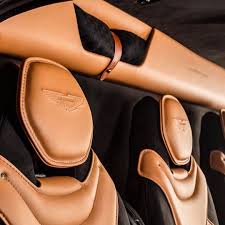
Italy is one of the world leaders in fashion, leather clothing, shoes and bags. In order to examine the position and characteristics of Italian natural leather, Italian leather technology, leather tanning centers in Italy, global competitors, export and import of Italian natural leather, Iran-Italy relations in the field of leather, Milan Leather Exhibition and introduction of top Italian leather brands.
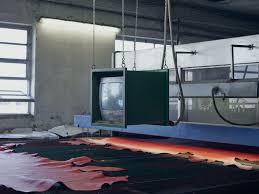
Italy is a country with 99% of its economic power in the hands of small and medium-sized enterprises and SMEs, and about 73% of its GDP is in the hands of this sector, and a very good organization and strategy is defined between small, medium-sized enterprises and large industries.
Meanwhile, major global brands are present in this country, especially in the fashion, clothing and leather industries, and make the most of the country’s production capacity and structure. In particular, the leather industry in the world is known for the superior reputation of Italian companies and brands.

Dalir leather industries in this report to present a report on the position of Italian leather, Italian leather technologies, major leather tanning centers in Italy, Italy’s global competitors, the export and import of Italian leather, Iran-Italy relations in the field of leather, Milan Leather Exhibition Italy and the introduction of the top brands of Italian leather and.
Italy is currently one of the most important world leaders in the field of fashion, especially leather clothing, shoes and bags. The tanning industry of this country, despite the highly advanced manufacturing industry has modern equipment, innovative designs and high quality has a global brand.
Italy has one of the highest incomes in the industry. According to estimates by the Italian Leather Industry Association, 15% of the world’s leather production and 60% of European finished leather production belongs to Italy. The industry considers itself a world leader in designing the quality of production of environmentally friendly products and having high innovation capacities.
In many countries around the world, Italian-made products are synonymous with high quality. 50% of raw leather products are used in shoes and footwear. 20% is used in leather goods and 19% in the furniture industry. The rest is used in the clothing sector.
Italy’s tanning industry in 2014 included 1,250 companies with 18,000 workers, earning over € 5 billion, of which $ 4 billion went to exports to 121 countries. China leads with 26%. Due to the prosperity of this industry and its high potential, Italy is forced to import non-tanned leather and leather (salambor) from abroad.
Only 5% of the required skin is supplied from domestic slaughterhouses, and the rest is imported from other European countries, Africa, Latin America, the Middle East, Australia and New Zealand.
The average annual turnover of this industry is 2.5 billion euro per year. This figure is equivalent to 129 million units of tanned leather and 34,000 tons of cumin leather. The composition of the skins used are: cow leather 71%, calf leather 8%, sheep leather 11%, goat leather 9% and other animals 1%.
In addition to the production and export of leather, Italy has the most prominent position in the production of machinery and equipment for the leather industry, from tanning to the manufacture of shoes and bags. Italy produces about 50% of the world’s shoe and leather goods machines, and 80% of the world’s tanning machines are manufactured in Italy. Italian tannery, presented. According to the same institute, about 6,200 people are employed in this industry.
Efforts to upgrade equipment and machinery is one of the keys to the development of the leather industry and related industries in Italy, which can be used as a suitable model for other countries, which has recently been considered by some domestic institutions and companies, including the brave leather industry. . Iran’s leather industry is in dire need of updating and upgrading leather making machinery.
The main tanning center (over 1330 industrial units) in Italy includes the provinces of Venice, Tuscany (Florence) and Campania in Naples. The towns of Croce Santa, Solofra near Naples are also major centers of natural leather production.
53% of the tanning industry is scattered in the province of Venice, 28% in the province of Tuscany in Santa Croce and Ponte Agua, 8% in the Campania in the Solofra of Naples and 5% in the Lombardy of Milan and the rest in other parts of Italy. In the provinces of Veneto (984 units), Tuscany (765 units), Campania (954 units) and Lombardy (75 units).
The industry specializes in the production of leather products for large surfaces used in furniture and car interior coatings. The history of the leather industry in Veneto dates back to the fourteenth century.
But development is key today after World War I. Most products are exported to the United States, Germany, the United Kingdom and Spain, and exports to Russia and Ukraine have increased in recent years.
The industries of this province are mostly active in the field of tanning and making cumin and upper leather, as well as consumer leather in the fashion industry. The highest concentration of Italian leather industry is in Tuscany, which has a history of more than two centuries of main and specialized activity in this field.
The turnover of the province’s leather industrial units constitutes 48% of the total turnover of the Italian leather industry.
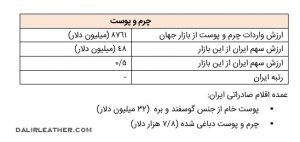
The industries of this province produce leather used in clothing, bags and shoes and other leather products of the country. The leather used in leather units is mostly goat and sheep leather and makes up 4% of all Italian leather products. The products of this province are mostly offered to the domestic market.
Due to the concentration of fashion factories in the province, Lombardy leather units produce more bags and shoes for famous Italian fashion houses.
Italy has had the traditional market of this industry for many years. But in recent years, big countries have emerged in this field. Currently, the Turkish leather industry is second only to Italy in terms of leather production quality.
Italian companies invested in China, India and Pakistan for reasons such as cheapness. Pakistan is currently the largest exporter of leather to the United States.
China is Italy’s most important competitor in this industry. China has had a negative impact on the Italian industry by producing cheaper and, of course, lower quality cars. China now accounts for 37% of world production and exports. For example, in the footwear export sector, Italy ranked second after China in 2014 with sales of $ 7.7 billion.
Leather production machines in Italy are compatible with up-to-date and high quality technologies. Italian-made machines have become more intelligent in providing information about technicians and the causes of defects.
One of the unique features of the Italian leather industry is the tendency and effort towards innovation with the aim of reducing environmental damage, energy consumption and production waste.
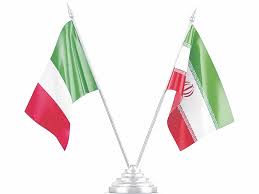
One of the latest innovations, introduced in May last year, is a combination of the leather industry and the medical industry, and was designed by Imaginalis, a company active in the field of medical equipment. The company made it possible to provide a three-dimensional scan of leather and metal products by making a computer-based computed tomography device, and by examining its quality, it realized the problems and defects, thus guaranteeing reductions in manufacturing as well as improving quality. .
According to the latest statistics of Onik, the Italian leather industry’s efforts to reduce environmental damage have reduced water consumption by 91%, chemical solvents by 95% and energy consumption by 495 in the last ten years. All Italian leather production units have recently been required to obtain an environmental standard certification, and 75% of all products have the green disc logo of the proprietary leather certification body, Ichek.
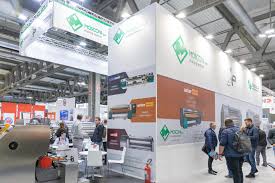
Italy is one of the leading exporters of leather and leather making machinery. In the field of export of crime machinery, as mentioned earlier, Italy produces 50% of the relevant machinery worldwide. According to statistics provided by Asomac, in 2013, 2014 and 2015, a growth of 15 to 11 percent per year compared to the previous year has been observed in the export of this sector in Italy.
Overall results show that exports of leather machinery and related industries in 2015 reached 500 million euro. Exports of the same products in 2014 were around 430 million euros. In terms of leather exports and exports of leather and tanning machinery and footwear, in 2014 and 2015 Europe was still the most attractive market for Italian exporters.
European countries have the second largest market for tanning machines with a 29% share of exports in this sector. These countries have allocated about 180 million euros of these exports. In recent years, Italy’s exports have shifted eastward.
In 2015, for example, the Asian market grew by 36%. In the field of leather exports, Italy is still in the top ranks in the world and 20% of world production is provided by this country. In the field of tanning machinery, China is the main export market of Italy. In the shoe machinery sector, India ranks first in imports from Italy, followed by China. In the leather machinery sector, most of Italy’s machinery exports are to Western Europe, but China is the first export route in Asia.
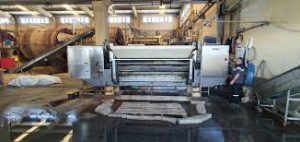
Iran-Italy cooperation in the field of leather industry has existed for many years. The most important specifications of these collaborations are as follows
First, Iran’s need for Italian technology in the tanning and leather sector: 1,880,000 volumes of raw leather are produced annually in the country, but the annual demand in the country’s heavy leather industry is about 4 million volumes of heavy cowhide.
However, most of Iran’s products are exported raw to Italy and other countries with technology. There are no statistics on the import of leather production technologies to Iran, but last year, a memorandum of understanding was signed between Iran and Italy by the Iranian Leather Industries Association to transfer technology and modernize the related leather industries in the country.
The second export of Iranian leather and salambor to Italy: In the latest statistics published by the Trade Development Organization of Iran on the export and import of the leather industry, the amount of export of leather and salambor was announced as 231,000 million and 388 thousand dollars. Most of the light leather imports (sheep and goat skins) are from Italy and also most of Iran’s exports are made to this country.
Third is Iran’s need to train manpower in this area: Italy has good capabilities to train Iranian leather makers. In this regard, a contract was concluded for training courses between the two countries by the Iranian Leather Industries Association, which was affected by this type of sanctions during the sanctions period, but in recent years, some technicians in this industry went to Iran for training courses. They traveled to Iran.
Fourth, the situation of skin production in Iran is a good incentive for foreign investors. In the current situation, leather factories are operating at 38% of their capacity. Our country’s exports in the field of raw leather production amount to 258 million dollars a year, which if converted into manufactured products, will have an added value of over one billion dollars. But unfortunately, despite our country’s ability to export leather, 0.5% of Iran’s light leather is exported raw and salambor, which can give foreign investors the necessary incentive to participate in the Iranian leather industry. The best way to develop economic and industrial cooperation with Italy, especially in the leather industry, is to use joint ventures.
Leather and Allied Industries Exhibition Milan – Italy (Lineapelle)
One of the largest and most important exhibitions and events held annually in Italy is the Milan Leather Exhibition. This exhibition offers leather and leather products in a completely exclusive way and brings together all manufacturers and those involved in this field from all over the world.
The Milan Leather Fair hosts many visitors from all over the world every year and plays a major role in the country’s tourism industry.
Some of the largest and most important brands of leather products in Italy
“Sophistication”, “elegance” and “social class” are some of the words that come to mind when you look at Italian fashion. It is the home of many of the world’s largest designers and textile and leather factories in Italy. That is why the fame of Italian clothing is complex all over the world and the type of clothing worn by Italians attracts every interest.
Old fashion-related fields and industries, along with long-standing family businesses, have made Italy always have a lot to say in the field of fashion, fashion and clothing. It should be noted that the Italian fashion world is not only Dolce & Gabbana, Prada, Giorgio Armani, Versace and Gucci, and there are many prominent brands that, although not as famous as the said international brands, but the aesthetics and mastery of Italian tailors in These brands are also followed with exemplary accuracy.
In the leather industry, world famous brands are active in Italy. Among the brands are Fendi, Giorgio Armani, Prada, Gucci, Versace and… which have been introduced under the brave leather industry. This list is arranged alphabetically in the English names of the brands:
It is one of the reputable manufacturers of leather products that has been active since 1911. The complex has been located in Springfield since its inception. The head of Bosca has announced that most of the brand’s products are made in Italy, China and Canada.
Worked in Italy since 1936 and has been producing luxury leather. The brand is currently based in New York City. But its products are designed and produced in Italy.
It is one of the famous international brands that has started its activity since 1958 and has famous and high products in the field of men’s suits, accessories and leather bags, and is especially known for its coats. Founded in 1930 by Alfredo Corneliani, the company distributes its products in more than 70 countries and in 2005 received the Leonardo Award for Quality from the President of Italy.
The Italian company Fendi, one of the luxury brands in the fashion industry, started operating in 1925 in Rome, Italy. This brand mainly produces bags and shoes, perfumes and colognes, leather products. Most fashion lovers know Fendi for her handbags such as Baguette, 2jours, Peekaboo and of course its fur products. Fendi has designed costumes for many Hollywood stars such as Nicole Kidman, Leo Tyler, Selena Gomez, Eva Mendes, Lindsay Lohan and many others, and currently has offices in over 160 boutiques in 25 countries around the world.
Is an Italian fashion design company, started in 1975 by Giorgio Armani. The company designs and manufactures many products including luxury goods, clothing, cosmetics, perfumes, interior design, jewelry, glasses and watches with different brands. In 2000, Forbes magazine named Giorgio Armani the world’s most successful designer. In 2001, the magazine ranked her ninth in the list of new members of fashion.
The Italian brand in the fashion and leather goods industry belongs to the Gucci Group, which is a subsidiary of the French company Kering. The Gucci Company was started in 1921 by Guccio Gucci in Florence. In 2009, the Gucci brand climbed to the 40th position in the top 100 brands, according to the Interband Institute. Gucci is Italy’s best-selling brand with 278 direct boutiques worldwide.
It is a specialty of Italian fashion for luxury goods for men and women, especially leather products. Prada is a manufacturer of glasses, leather, shoes, suitcases and handbags, which was started by Mario Prada and his brother in 1914. Prada is headquartered in Milan, Italy. In 1919, Prada became the official supplier of the Italian royal family. This was at a time when Prada’s worldwide reputation was growing. Prada won the American Fashion Designers Association International Award in 1993 and the Designer of the Year Award in 1995.
The brand was launched in 1924 and had a turnover of over € 600 million in 2011. Fabric production was once the only specialty of this old brand, but since about twenty years ago, the top fabrics of this brand in the form of stylish men’s clothing have been a part of the wardrobe of well-dressed men. Today, Loro Piana is known as one of the most prominent and reputable manufacturers of woolen and cashmere clothing in the world.
The company produces luxury leather goods and exquisite handmade stationery as well as perfumes and colognes. The company began its journey to great global success with the founding of its first store in 1774 by Francisco Pineider in Florence, Italy. Presenting stunning designs and handwriting on the finest papers was the first activities of this brand that brought great success to this name. In 2001 and 2009, Pine Eider was chosen by the Italian government as the official host of the annual summit of the eight industrialized nations.
It is a popular name that started in Florence in 1928 and produces and sells luxury leather products. It is also the name of a shoe and fashion museum in the city. Salvatore Fergamo, a businessman and fashion designer, was very interested in shoemaking and started his career as a shoemaker at the age of nine. As an international manufacturer, it is increasingly launching its products, which include a variety of men’s and women’s luxury shoes, bags, glasses, accessories, watches, perfumes and even clothing in branches around the world, including Florence. Sells Rome, London, New York, Beverly Hills, Seoul, Singapore, Shanghai and Tokyo.
In 1972, Stefano Ritchie began manufacturing handmade ties in Italy, and later produced suits, men’s shirts, and so on. Stefano Ricci Luxury Shopping Mall is the best place to buy Italian menswear. All heads are handmade. Mr. Goldsmith, the maker of these heads and other men’s accessories, is making the heads from precious stones, and wallets, belts, shoes, handbags, and all kinds of men’s bags from leather.
Launched in Florence in 1969, it focuses on leather handbags and other leather goods. In the long run, this name has its main activity in the field of leather and in the form of a combination of hand-made and machine-made leather products.
This name is known as TL and has been operating since 2004. In general, in Italy, the Tuscan region is famous for its leather. There are shops in this area that have been offering quality leather products such as bags, coats, belts and wallets for years; But the price of these leather products is definitely high due to their quality. Inspired by this place, Tuscany leather has created this brand with originality in the field of leather and has achieved many successes nationally and internationally.
It is an Italian clothing and fashion house, started in 1978 by Gianni Versace. The first Versace boutique was established in 2000 in Reggio Calabria. Today, the Versace brand is one of the largest and most famous fashion houses in the world. The Versace brand is an Italian fashion house and brand that quickly gained worldwide fame with the first store it opened; Today, it has become a global and well-known brand in the field of clothing, cologne, shoes and..